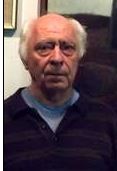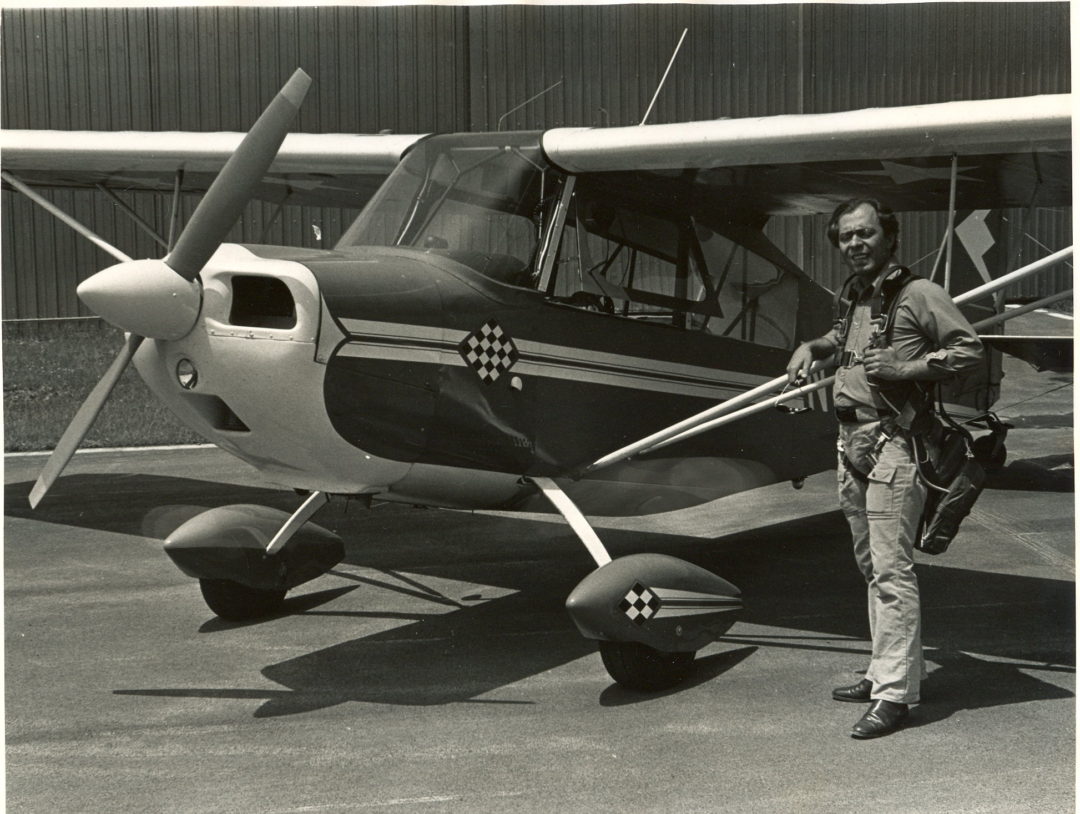Steve Poleskie with his first airplane, a Champion Citabria 7ECA, 1972
***
Teaching Myself to Fly an Airplane
by Stephen Poleskie
Columnist
When I mentioned that I was writing an article about teaching myself to fly, my friend asked: “Who do you think you are, Leonardo da Vinci?” So I know a clever person, who must have read Leonardo’s notebooks. In case you haven’t read these texts, when he wasn’t working on paintings, murals, or designing war machines, Leonard often made drawings for devices to get himself into the sky. Most of these involved jumping from a castle tower into the moat below. Thus, some people credit da Vinci with inventing the parachute.
I explained to my young friend that the flying article was actually more about my being an autodidact, a word he surprisingly was not familiar with. I suppose that in this day and age, when one is encouraged to stay in school until you can’t borrow any more money, a “self-taught person” is a bit of an anomaly. I take pride in having taught myself everything that was important to me, including screen printing, which I learned by reading a pamphlet given out free by a Sherwin Williams paint store in Pennsylvania and then taught at Cornell University for 33 years.
My flying story begins in a deer stand. When I moved up to Ithaca from New York City, I can’t say that I wasn’t bored. I did miss my evenings at Max’s, gallery openings, and the rest of the NYC art world milieu. In my free time I began doing the things that people did in the fall in upstate New York. One of these activities was deer hunting.
I won’t elaborate how I got into a deer stand, crouched waiting for my friends to flush out a buck to come running from the neighboring fields for me to shoot. However, I will say that I was uncomfortable; cold, cramped and bored. And then I heard a familiar sound. I looked up and saw a small airplane passing overhead. This was it — that is where I should be; up there in the clear blue sky. I loved airplanes, having flown models in my youth, and even taken a few flying lessons. I jumped out of my hiding place, ran for my truck and drove to the local airport.
“But it’s December,” Mr. H, the chief flight instructor and owner of the flying school reminded me. “No one learns to fly in the winter, the weather’s too bad. Come back in the spring.”
“But I want to start right now,” I insisted, full of enthusiasm.
“Okay, come back on the next nice day, in the meantime buy this book,” Mr. H snarled, sliding a tome across his desk, “and learn everything in it before you come around again. You will notice that my name is mentioned in the acknowledgements.” Alas, I had met a man who had a bigger ego than mine.
My lessons went well. I was working with a flight instructor named Rogie. I could take off and land and in a short time was allowed to do this all by myself; flying solo it’s called. The problem came when I asked Rogie to teach me how to do spins. Spins were no longer in the curriculum, Rogie explained. It seems that too many pilots had crashed practicing spins, so the FAA had decided pilots no longer needed to know spin recovery techniques. The theory was that if you never got into a spin you would not need to know how to get out of one. But if someone accidentally got into a spin and didn’t know how to recover, well that was just too bad. I convinced Rogie to demonstrate a spin and recovery, which he did. I can still recall the terror on his face as we rotated one turn, which was all he would do.
But I was hooked. I loved the experience. I had grown tired of practicing takeoffs and landings and turns about a point. Whenever I was sent off solo I would go out to the practice area and climb to a safe altitude, and then spin the airplane to my heart’s content.
As part of the curriculum, I had to take a check ride with the chief flight instructor, the owner, Mr. H. When we were taxiing out I noticed that the artificial horizon was malfunctioning. This is an instrument one used to keep the wings level when flying blind, that is in fog or clouds without ground reference.
We got to the end of the taxiway and I did a run up, checking the engine gauges and magnetos prior to take off. Then Mr. H told me to taxi back to the hangar. I had failed the check ride, he informed me, because I had taxied out with an inoperable artificial horizon.
I argued that as it was a perfectly clear day we would have no need for the artificial horizon. Then I revealed what would be my downfall. I explained that whenever I spun the airplane the artificial horizon tumbled, but always came back. I didn’t know at the time that aerobatic airplanes had non-tumbling instruments, and this Piper was not an aerobatic airplane.
“So you’re the one who has been spinning my airplanes!” Mr. H screeched, adding, “You are out of my flying school. You are a menace to yourself and everyone around you. You have no business being in an airplane.”
Kicked out; so what was I to do? The only other flying school on the field was a flying club, and I was not a joiner. I had enough of meetings back at my college department. If no one would teach me how to fly I would teach myself. But to do that I would need to have an airplane, and the two flying schools were the only ones on this field who rented aircraft. I decided that I would have to buy an airplane.
I found it in a hangar at an airport in Pennsylvania, a Champion Citabria 7ECA. This was a real aerobatic airplane, if only a beginner’s model, and it was used, which put it in my price range. I took a demonstration ride, and we did a few loops, rolls and spins. I would be back next week with the money. As the Citabria was based on an older design and had its third wheel on the rear, I would also need to be checked out for flying a tail wheel aircraft.
How I accomplished this frenzied project I cannot recall. But I do remember visits to my bank manager, and taking time with a local free-lance flight instructor who owned a tail wheel airplane. I got a friend to fly me down to Pennsylvania. I would be flying home in my own aerobatic airplane.
The transaction was complete. The local flight instructor, who had demonstrated the Citabria to me, checked me out in the airplane. After a few take offs and landings, at the small grass field wedged between a mountain and a river, the instructor got out. He shook my hand and wished me a good flight home. I told him I needed one more thing, a log book endorsement for the cross-country flight. You see student pilots, which I still was, couldn’t go flying off anywhere without an endorsement from their flight instructor. I remember the concerned look on the man’s face. He was reluctant to sign my log book because of my limited experience. Then he must have remembered the commission on the sale he would lose if I backed out of the deal. He signed.
I taxied out and took off. The landing would be no problem I thought, since the airport that I was headed for was a mile long and paved. As the Citabria climbed out I reached into the door pocket for a chart. To my surprise there was none there. The flying school airplanes always had charts in the door pocket, but this was my airplane and neither I nor the previous owner had supplied one. I turned back, but the runway at the airport I had just departed looked so short. I decided to head for home. I knew the way without a chart, I had driven it: follow the river to Binghamton and then head northwest until I see Lake Cayuga. The airport is on the East side of the lake.
Successfully arrived in Ithaca, I parked my Citabria on the ramp and went inside the Fixed Base Office to arrange for fuel and hangar space. Mr. H was inside looking out the window. Spying me he gestured for me to come over. He pointed to the strange Citabria on the ramp. “Now there’s a real airplane,” he said, “If you ever learn how to fly, and get good enough, some day you might be able to fly something like that.”
“That’s my airplane,” I revealed. “I just bought it in Pennsylvania and flew it here.”
Mr. H glared at me, an expression of disbelief on his face. “I suggest you return that airplane to whoever you bought it from and get your money back before you kill yourself in it, “ he said, turning and walking away.
I didn’t take his advice.
About the author:
 Stephen Poleskie’s writing has appeared in journals in Australia, the Czech Republic, Germany, India, Italy, Mexico, the Philippines, and the UK, as well as in the USA, and in three anthologies, including The Book of Love, (W.W. Norton), and been twice nominated for a Pushcart Prize. He has published five novels and two story collections. Poleskie has taught at The School of Visual Arts, NYC, the University of California/Berkeley, and Cornell University, where he is a professor emeritus and been a resident at the American Academy in Rome. He lives in Ithaca, NY. Website: www.StephenPoleskie.com.
Stephen Poleskie’s writing has appeared in journals in Australia, the Czech Republic, Germany, India, Italy, Mexico, the Philippines, and the UK, as well as in the USA, and in three anthologies, including The Book of Love, (W.W. Norton), and been twice nominated for a Pushcart Prize. He has published five novels and two story collections. Poleskie has taught at The School of Visual Arts, NYC, the University of California/Berkeley, and Cornell University, where he is a professor emeritus and been a resident at the American Academy in Rome. He lives in Ithaca, NY. Website: www.StephenPoleskie.com.

Steve Poleskie is and unabashed explorer who is self taught, and bold in many venues such as teaching himself to fly an airplane, and also to do his acclaimed Art and Writing. This story illustrates this very nicely.